Join Our eNewsletter!
Subscribe to our monthly newsletter to receive encouraging advice to help you lead a healthy lifestyle.
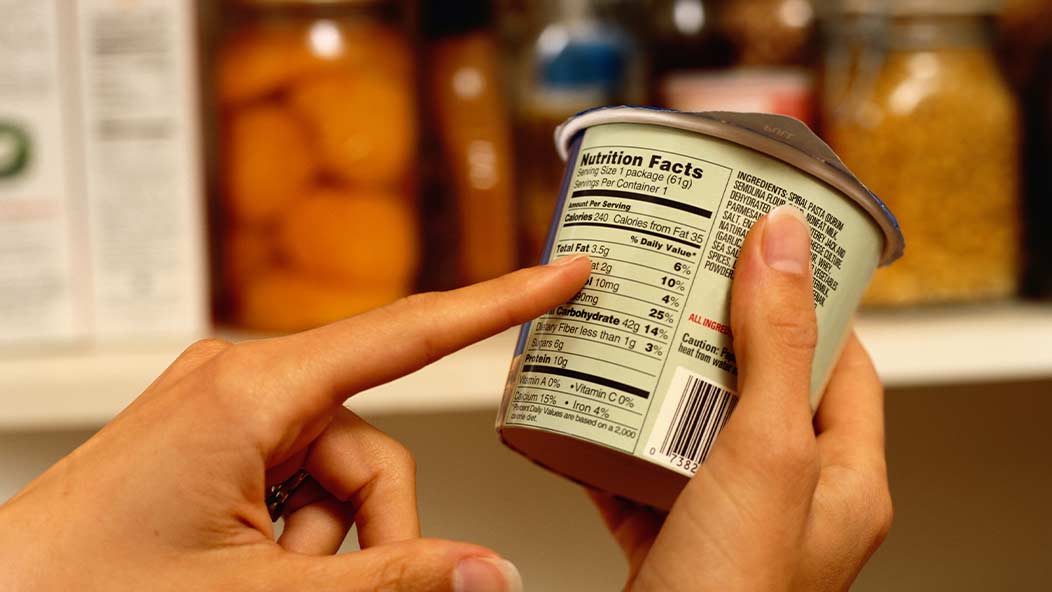
How To Read a Nutrition Label
Knowing how to read a nutrition label can help you make better decisions about what you eat and how much. But nutritional labels can be overwhelming if you don’t know what to look for and what the information means.
The following information sheds some light on food labels so you can read them with confidence and use them to your advantage. Here’s a breakdown of the elements on the label.
Key Information on a Nutrition Label
-
Serving size: You should pay attention to serving size. If you don’t, you risk consuming more than the recommended daily percentage of calories, carbohydrates, fats, and other vitamins and minerals.
Labels show the nutrition facts for one serving so you should multiply all the values on the label by the number of servings you eat. For example, if you eat two servings, multiply all the values by two. If you eat half of a serving, divide all numbers in half to determine the amount of each nutrient.
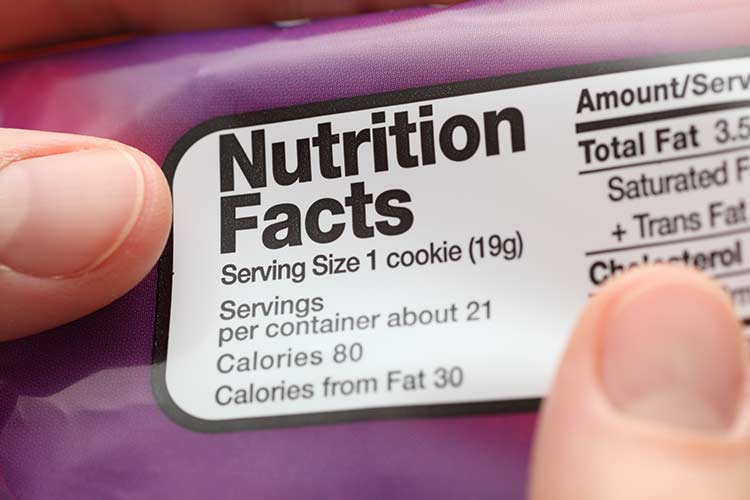
Keep in mind that serving size isn’t a recommendation of how much to eat or drink. The serving size is the amount that most people typically eat or drink, not the amount that you should eat or drink. Also, one package of food may contain more than one serving.
Some containers may also have a label with two columns – one column listing the number of calories and nutrients in one serving and the other column listing this information for the entire package. Packages with “dual-column” labels let you know how many calories and nutrients you are getting if you eat or drink the entire package at one time.
-
Calories: Eating too many calories per day is linked to excess weight and obesity. To achieve or maintain a healthy body weight, balance the number of calories you eat and drink with the number of calories your body uses. The Food & Drug Administration (FDA) uses a 2,000-calorie/day diet as the standard for most Americans, but your calorie needs may be higher or lower depending on your age, sex, height, weight, and physical activity. Keep in mind that the number of calories you get from a food item depends on the number of servings you eat.
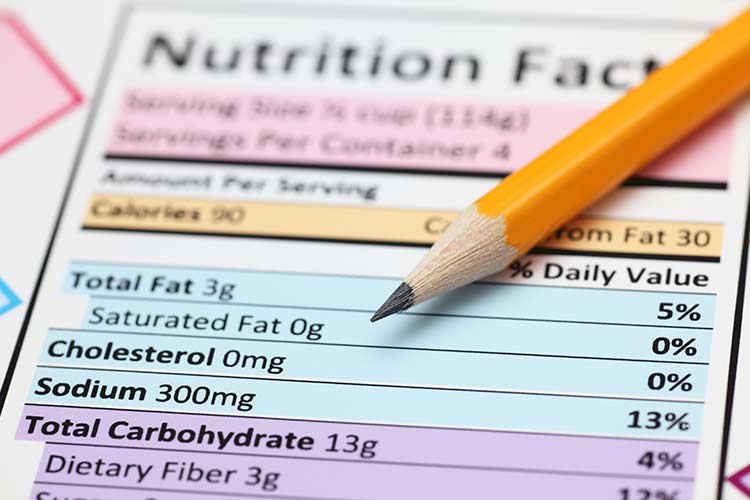
-
Nutrients: Underneath the calories are the key nutrients that play a role in overall health, including fat, cholesterol, sodium, carbohydrates, fiber, sugar, protein, vitamin D, calcium, iron, and potassium. Saturated fat, sodium, and added sugar are nutrients to get less of, and fiber, vitamin D, calcium, iron, and potassium are nutrients to get more of. Based on the daily recommendations, these nutrients are listed in grams, milligrams, or % daily value. Here are some guidelines to keep in mind:
-
About 30% of our daily calories should come from fat. For a 2,000-calorie diet, that would be about 66 grams of total fat per day. Choose foods that are low in saturated fat. Aim for less than 20 grams of saturated fat a day. Keep in mind that not all fats are bad. Replacing foods that are high in saturated fat with foods that are higher in unsaturated fats, like fish and nuts, can help improve cholesterol and lipid levels.
-
Cholesterol is typically found in animal food products like meat, eggs, and dairy. Aim for less than 300 mg of cholesterol a day.
-
Aim for less than 2,300 mg of sodium a day. You can reduce the amount of sodium in your diet by reducing the amount of salt you use in cooking, but sodium also comes from ingredients in packaged foods. To reduce the amount of sodium in your diet, choose no-salt-added or low-sodium options whenever possible.
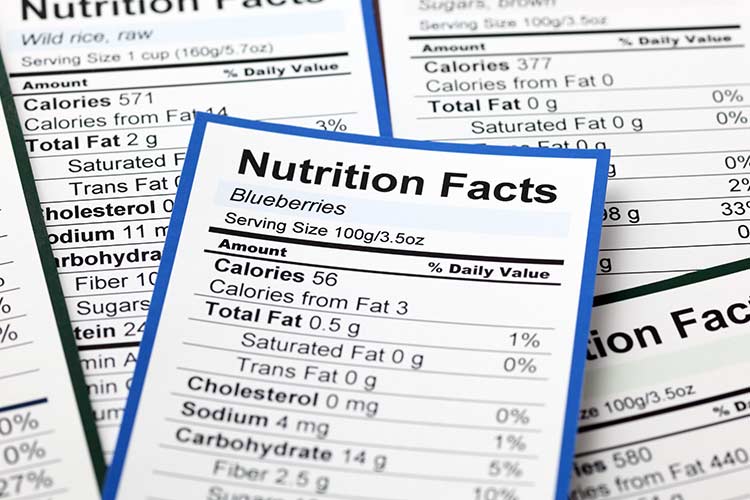
-
Carbohydrates are an important source of energy. There are three types of carbohydrates: starches, fiber, and sugar. When choosing carbs, the key is choosing complex carbs.
Complex carbohydrates are digested slower; therefore, they are less likely to cause a rapid spike in your blood sugar like refined carbohydrates. Examples are whole grains and legumes.
Processed foods tend to be high in carbs, especially refined carbohydrates, while also being very low in vitamins, minerals, and fiber. Choosing fewer processed carb foods and paying attention to how much you are eating can make a big difference in your blood sugar and overall health.
-
Fiber helps to digest food, helps you feel satisfied longer, and can help lower cholesterol levels. Women ages 18 – 50 years should aim for 25 grams of fiber a day. Men ages 18 – 50 years should aim for 30 – 38 grams of fiber a day.
-
Some foods naturally contain sugars, such as fruit, dairy, and grains. Other foods contain sugar added during processing, such as soda, sweets, and baked goods. You may have heard added sugars referred to by other names or seen one of these listed in the ingredients in a food label. Dextrose, fructose, lactose, table sugar, beet sugar, honey, corn syrup, turbinado, and agave are just some of the many names for added sugars. When consumed with solid fats and excess energy intake, added sugars have been linked to health concerns, including excess weight and obesity, Type 2 diabetes or prediabetes, inflammation, and cardiovascular disease. Aim to eat less than 10% of total calories from added sugar.
-
For a 2,000-calorie diet, aim for 20 – 25 grams of protein at a meal and 50 – 60 grams total a day. Focus on lean meat, fish, and poultry, as well as meatless protein options, such as nuts, seeds, eggs, beans, and soy, which typically have less fat and more fiber.
-
-
Vitamins and minerals: Food items are considered a good source of a vitamin or mineral if % DV (the percentage of the daily value for each nutrient in a serving of the food) is 10% or greater. The vitamins and minerals that are listed on the nutrition label are:
-
Vitamin D: important for strong bones
-
Calcium: important for strong bones
-
Iron: important for blood health; helps prevent anemia
-
Potassium: important for blood pressure and cardiovascular health
-
-
List of ingredients: A food label lists ingredients according to how much is used. The ingredient used the most will be listed first, and the ingredient used the least will be listed last. Paying attention to the first three ingredients listed is a good rule of thumb because they make up the most significant part of what you’re consuming. A long list of ingredients can be a red flag that a food is unhealthy. The list of ingredients is also where you need to look for hidden sugars. If you see words like “corn sweetener,” “corn syrup,” “dextrose,” “fructose,” and “high-fructose corn syrup,” they are all synonyms for sugar. You should also consider artificial sweeteners like sucralose, saccharin, aspartame, and acesulfame. All of these artificial sweeteners should be consumed in moderation.
-
Percent Daily Value: The % DV tells you how much of a nutrient contributes to a 2,000-calorie diet. The U.S. Food and Drug Administration sets a recommended daily amount of each nutrient. The % DV tells you how one serving of a particular nutrient compares to the total daily recommendation. Food that’s 5% DV or less is considered low. Food that’s 20% DV or is considered high.
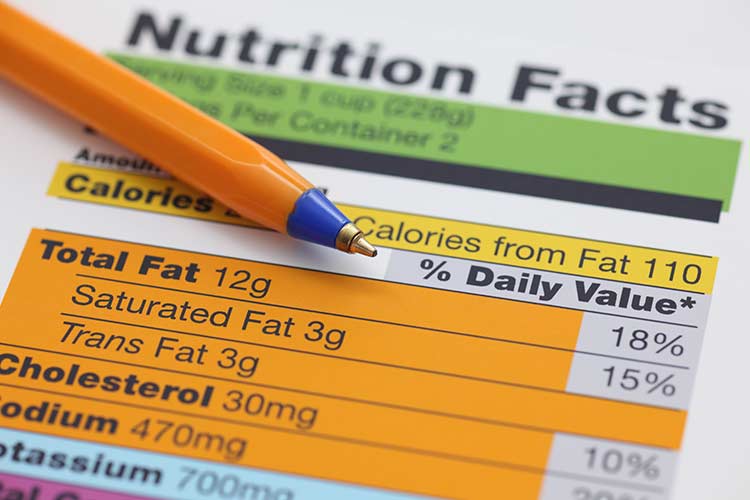
The Lowdown on Light, Low Fat, and Low Carb
When you are shopping, you may think you’re making healthy choices when you reach for foods labeled as light, low fat, or low carb. It’s essential to know and understand what each of these terms mean.
-
Light – A “light” version of a food or beverage means it was processed in a way to reduce the calories or fat. Sometimes, this is too good to be true because the food or drink is “watered down.” Check whether additional ingredients, like sugar, have been included to compensate for the reduced calories and fat.
-
Low fat, low calorie, and low carb – Foods with these labels can be deceiving. There is a legal limit as to how many calories, fat grams, or carbohydrates these foods contain for them to be considered “low fat,” “low calorie,” or “low carb.” Because of this, the serving sizes can be extremely small. If you’re not careful, you can defeat the purpose by consuming multiple servings, which equals the same amount of fat, calories, and carbs as the regular version.
Multigrain and organic are also words that have a healthy ring to them but may not live up to these expectations. For food to be truly “whole grain,” it shouldn’t contain refined grains. When a food contains refined grains, it means the grains have been stripped of essential nutrients during processing. Organic foods are produced without using pesticides or chemical fertilizers. Cattle and poultry raised without injected hormones or antibiotics are also considered organic. While organic foods may be free of these, it doesn’t mean they have fewer calories, fat, proteins, and carbs.
Knowing the different information on a nutrition label and what it means can help you make better decisions about what you’re feeding yourself and your family. Carefully studying the ingredients and not being fooled by deceptive labels will help ensure you get the nutrients you need and avoid the stuff you don’t.








